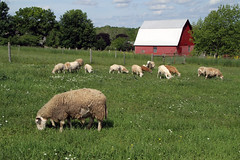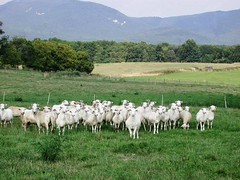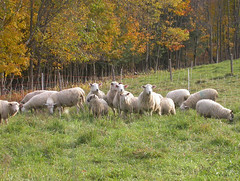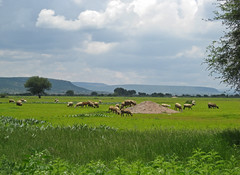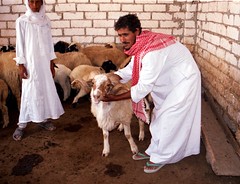|
|
U.S. Sheep Industry According to the 2017 Census of Agriculture, there are 101,387 sheep farms in the United States. Large sheep operations, which own 80 percent of the sheep, are located primarily in the Western United States. Texas, California, and Colorado have the most sheep. Small producers, those owning less than 100 sheep, comprise the majority of sheep operations, but own less than 20 percent of the sheep. 2020 U.S. Sheep and Lamb Inventory - Top 10 states
A small industry Compared to other animal and agricultural industries, the sheep industry is very small, accounting for less than 1% of total U.S. livestock receipts. 2018 U.S. Livestock Slaughter
Over the past 200 years, the U.S. sheep population has come full circle. From 7 million head in the early 1800's, sheep numbers peaked at 56 million in 1945, then declined to less than 7 million head on January 1, 2003. At the same time, industry emphasis has changed from wool to meat. Sheep numbers increased slightly in 2005 and 2006, the first time since 1990. They also increased by 1 percent in 2015 and 2016. The number of sheep operations increased from the 2012 to the 2017 census. The American Sheep Industry Association is currently encouraging sheep producers to increase the size and productivity of their flocks. Visit the Grow Our Flock web site to learn about ASI's Let's Grow program. Home on the range Sheep in the Western United States are often raised under traditional range conditions, where flocks graze unfenced pastures under the watchful eye of shepherds or sheepherders. Some range flocks graze public lands (for a fee), while others graze privately owned land. A range "band" consists of 1,000 ewes and their lambs. Wool production is still important in the range sheep industry. Fine wool breeding predominates. Most range ewes have Rambouillet blood. Lamb feeding industry Colorado is the most concentrated lamb feeding area in the United States. Other states that feed a lot of lambs include Texas, California, Iowa, and Oregon. Lamb feeders purchase 60 to 90 pound lambs for finishing in feed lots. Sometimes, lambs are grazed on alfalfa fields. The lamb feed lot industry has struggled in recent times due to higher feed costs and higher feeder lamb prices, brought about by the increased demand for light weight slaughter lambs by non-traditional markets. Small farms While the U.S. sheep industry is still dominated by small numbers of large operations, these operations continue to decline for various reasons. At the same time, small flocks are increasing, especially in the eastern half of the United States, where the majority of lamb is consumed. To be profitable, small flocks must be productive and have access to excellent markets. Sheep are especially popular on small farms where sustainable farming practices are favored, such as pasture-finishing of lambs. Making money with sheep As with other agricultural enterprises, sheep farming is not a "get-rich-quick" scheme. The profit margins are narrow. To make money raising sheep, you would need at least several hundred ewes, probably more than 500. While there are some farmers who make a majority of their income from sheep farming, sheep raising is more often a part-time or secondary enterprise of a farm. For some, it is a hobby, retirement activity, or 4-H project. Sheep farmers derive their income from the sales of lambs and wool and related products. Though it varies by state and farm, most income comes from the sale of lambs. Dairy sheep farmers have three sources of income: lambs, wool, and milk (or dairy products). Some farmers receive income by leasing their sheep out for grazing. Some sheep are raised for bio-medical purposes (research, blood, etc.). World sheep numbers According to the Food & Agricultural Organization (FAO) of the United Nations, there are more than 1.2 billion sheep world wide. Sheep production is increasing in some countries; declining in others. While China has the most sheep (by far), Australia and New Zealand dominate world markets for lamb and wool. 2017 World Sheep Inventory - Top 10 countries
The United States is not a major sheep-producing country. Lamb and mutton imports usually account for more than half of U.S. lamb consumption. Wool imports were almost $12 million in 2018. The US is the world's largest importer of sheep cheese. <== RAISING SHEEP |
||||||||||||||||||||||||||||||||||||||||||||||||||||||||||||||||||||||||
|
|

